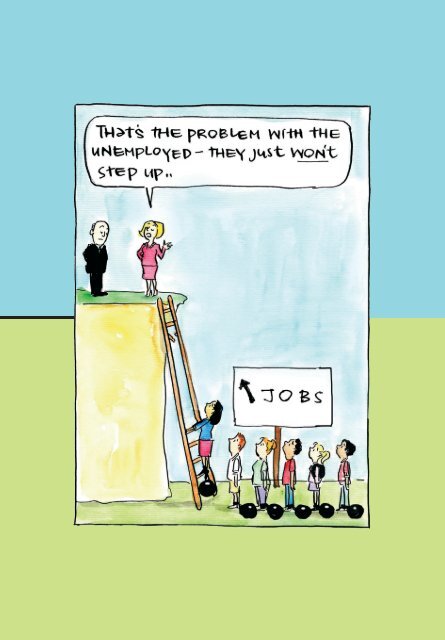WHEN THE JOBS AREN’T THERE EXPLORING THE LANDSCAPE
2etAD5M
2etAD5M
Create successful ePaper yourself
Turn your PDF publications into a flip-book with our unique Google optimized e-Paper software.
<strong>WHEN</strong> <strong>THE</strong> <strong>JOBS</strong> <strong>AREN’T</strong> <strong>THE</strong>RE:<br />
<strong>EXPLORING</strong> <strong>THE</strong> <strong>LANDSCAPE</strong><br />
Sarah Jewell<br />
Anglicare Australia’s research and advocacy agenda seeks to highlight the<br />
experience of people who are ‘doing it tough’ and to identify the paths we<br />
can pursue to bring them into the heart of our society. Anglicare agencies<br />
work with people, families and communities around the country to address<br />
the conditions that lead to deprivation and disadvantage. The programs<br />
our members provide are as diverse as the communities we serve. From<br />
family services, youth programs, and aged care, through to emergency<br />
relief, housing, and employment services, our members support those<br />
who are in need, to transform Australia into a society where no one is left<br />
behind. The annual State of the Family report provides an opportunity to<br />
dive deeply into the lived experience of the people we work with, and to<br />
discover policy solutions that stem from understanding these experiences.<br />
What is the measure of a good life in modern Australia? While every<br />
person in Australia will have unique aspirations of their own, for many<br />
of us, a good life depends on having an adequate income to meet our<br />
needs, safe and secure housing, meaningful work, high quality education,<br />
and access to health care. These factors are fundamental to people being<br />
able to exercise control over their own lives, and to ensuring the health,<br />
wellbeing and inclusion of individuals and their families in our community.<br />
Anglicare Australia recognises that secure employment is a critical factor<br />
in how people meet their basic needs (housing, food and bills), work<br />
toward their life goals, and participate in society. Adequate income and<br />
secure work are vital contributors to pave the way out of poverty and<br />
disadvantage. Given the significance of the issue, the focus for this year’s<br />
State of the Family is employment.
Employment was a key issue in the 2016 federal election, epitomised in the<br />
slogan “jobs and growth”. Unfortunately, slogans such as this perpetuate<br />
a myth that employment is a simple equation: one person plus one job<br />
equals long-term employment. But for people looking for their first job,<br />
for those who need support to re-enter the workforce, and for people<br />
whose positions have been made redundant due to industry disruption, it<br />
often seems the right jobs just aren’t there. In this report we unpick some<br />
of the complexities around employment and unemployment, addressing<br />
the real and pressing questions our members are facing every day in<br />
communities across Australia. Some of the questions we ask include: How<br />
can younger workers get their foot in the door? What should people do<br />
when the job market radically changes around them? How can the needs<br />
of employers and employees be met as people’s capacity to work ebbs<br />
and flows over a lifetime?<br />
2<br />
Debunking the myth<br />
The public narrative around unemployment tends to focus on individual<br />
deficiencies. Too often, policy and politics rest on the easy, yet unhelpful,<br />
notion that people are excluded from the workforce through their<br />
own fault. Such narratives<br />
create an environment where<br />
government measures related to<br />
unemployment are focused on<br />
compliance rather than based on<br />
an understanding of the personal<br />
and systemic factors that have led<br />
to unemployment. This leaves<br />
job seekers vulnerable when<br />
governments are looking for<br />
ways to reduce their spending.<br />
It seems easier for governments<br />
to encourage people off income<br />
support payments by reducing<br />
payments and introducing waiting<br />
Too often, policy<br />
and politics rest<br />
on the easy, yet<br />
unhelpful, notion<br />
that people are<br />
excluded from the<br />
workforce through<br />
their own fault.
periods than it is to work with job seekers and employers to create<br />
sustainable employment outcomes.<br />
In view of these perceptions, Anglicare Australia commissioned a report<br />
earlier this year to examine the number of jobs being advertised across<br />
Australia, and the likelihood that disadvantaged job seekers (such as the<br />
long-term unemployed, or young people with limited work experience)<br />
will have access to these vacancies.<br />
The Jobs Availability Snapshot by Michelle Waterford (2016) is a<br />
standalone research report, which we have published on the Anglicare<br />
Australia website alongside this edition of State of the Family. The report<br />
uses Australian Government employment data from June 2015 to May<br />
2016 to look at the proportion of advertised job opportunities across<br />
Australia that are appropriate for people with limited skills, qualifications<br />
and experience. It asks two key questions: are there enough jobs? and<br />
what works to help people get and keep jobs?<br />
The Jobs Availability Snapshot finds there are many more opportunities<br />
for people with professional skills, qualifications and extensive experience<br />
than there are for people with limited experience or qualifications. Although<br />
there has been growth in the number of job advertisements across all skill<br />
levels, the strongest growth has been in openings requiring diploma or<br />
degree qualifications and at least three to five years’ experience. While<br />
jobs suitable for people with limited skills and experience are advertised,<br />
the Jobs Availability Snapshot finds job vacancies at the lowest skill levels<br />
have been in an overall decline since 2010.<br />
3<br />
The Jobs Availability Snapshot also finds that, at a national level, there are<br />
two job seekers per advertised position at a low skill level. As Waterford<br />
argues, these figures suggest that roughly half the job seekers complying<br />
with their government-mandated Job Plan will not find jobs and so are<br />
“structurally excluded from the labour market” (p. 7).<br />
The picture is grimmer still when we look at the number of low-skilled<br />
vacancies at state and territory level. In Tasmania and South Australia, for<br />
example, the disparity between available low-skill positions and people
looking for work at that level is much higher, with over four job seekers<br />
per advertised low-skill vacancy in South Australia, and five in Tasmania.<br />
One possible explanation for these figures may be that entry-level<br />
positions are frequently advertised in ways not captured by government<br />
data, such as advertisements in shop windows or word-of-mouth, but it<br />
also points to the job seeker catch-22: people need experience to get a<br />
job, but also need a job to get experience. Unless job seekers have some<br />
form of experience, such as an apprenticeship, internship, or short-term<br />
placement; job-hunting skills (a polished resume and interview manner);<br />
good social skills; or are already personally connected to someone in the<br />
workplace, they are very likely to be overlooked by potential employers.<br />
4<br />
The question for our sector then becomes how best we can work in<br />
partnership with people to help them build the skills necessary for<br />
the workplace, at the same time encouraging employers to provide<br />
opportunities for people who might otherwise be categorised as<br />
unsuitable.<br />
Life-first – taking a partnership approach<br />
The evidence from our network<br />
and beyond demonstrates that<br />
there are significant, structural<br />
barriers to participation, but there<br />
are also ways to overcome them.<br />
Research across the Anglicare<br />
network (Goodwin-Smith and<br />
Hutchinson, 2014) has identified<br />
the value of acknowledging and<br />
incorporating the individual<br />
circumstances of disadvantaged<br />
job seekers, and of harnessing<br />
their job aspirations. Rather than<br />
taking a work-first approach to<br />
The evidence from our<br />
network and beyond<br />
demonstrates that<br />
there are significant,<br />
structural barriers<br />
to participation, but<br />
there are also ways to<br />
overcome them.
unemployment, which focuses<br />
primarily on finding work and<br />
undertaking training or workfor-the-dole<br />
placements, the<br />
Anglicare network prefers<br />
a life-first approach. We<br />
acknowledge the considerable<br />
barriers unemployed people<br />
face in finding pathways into<br />
employment and we put in place<br />
multi-faceted interventions that<br />
build their skills and capacities<br />
to achieve the sustainable<br />
outcomes they seek. We<br />
understand that working with<br />
people who are disadvantaged<br />
in the employment market takes<br />
time and resources, as well as<br />
The Anglicare<br />
Network prefers<br />
a life-first approach.<br />
We acknowledge<br />
the considerable<br />
barriers unemployed<br />
people face in<br />
finding pathways<br />
into employment ...<br />
a genuine commitment to the aspirations and goals of individual job<br />
seekers. Above all, we recognise the person at the centre of workforce<br />
exclusion as someone with strengths and aspirations and we provide<br />
them with opportunities to develop the skills and knowledge they need<br />
to secure and maintain employment, and to use in other aspects of<br />
their lives.<br />
5<br />
A partnership approach is also helpful in developing successful working<br />
relationships with employers. Local partnerships between community<br />
organisations, education providers, and employers can develop the<br />
infrastructure required to ensure disadvantaged job seekers have ways<br />
into the job market and allow employers to build their capacity to<br />
support people who they may have otherwise overlooked. Benefits from<br />
these partnerships flow on not only to entry-level job seekers but also to<br />
experienced workers who need other types of support or flexibility.
Building on our approach<br />
The Turnbull Government’s recently announced plan to use an<br />
investment approach to get young people working presents both an<br />
opportunity and a threat to life-first approaches. The opportunity lies in its<br />
acknowledgement that early intervention and early investment can make<br />
a significant difference in a person’s situation, and that we should be using<br />
data and evaluation to understand what approaches work. If, however, the<br />
public narrative remains focused on the size of the welfare budget, rather<br />
than the provision of the most effective possible support for young job<br />
seekers, the Government’s proposed approach poses a threat. It leaves<br />
programs that work with marginalised groups vulnerable to funding cuts<br />
and risks government investment and support for groups that need it<br />
the most.<br />
6<br />
In this State of the Family<br />
report, we argue the need for<br />
a responsive social security net<br />
that recognises and addresses<br />
individual and systemic reasons<br />
for unemployment. We present<br />
approaches that are holistic and<br />
that put people and their lives<br />
first, and describe initiatives that<br />
seek to build lasting partnerships<br />
between job seekers, employers<br />
and their communities.<br />
In this State of the<br />
Family report, we<br />
argue the need for<br />
a responsive social<br />
security net that<br />
recognises and<br />
addresses individual<br />
and systemic reasons<br />
for unemployment.
In the chapters that follow,<br />
• Sally James, Farah Farouque and Diane Browne explain how local<br />
partnerships can provide opportunities for young people in youth<br />
unemployment hotspots.<br />
• Paul McDonald argues that the biggest thing we can do to change<br />
the record of poor educational and employment outcomes for<br />
young people leaving state care is to extend the leaving care age<br />
from 18 to 21.<br />
• Majon Williamson Kefu explains the difference it makes when postprison<br />
release programs are built on personal connections and<br />
relationships, rather than compliance.<br />
• Aaron Wyllie explores, from an employer’s perspective, how<br />
training, mentoring and work placements can meet the needs of<br />
disadvantaged job seekers and aged care providers.<br />
• Kate McGarry shares the South Australian experience of the<br />
demise of the car manufacturing industry, and points to affected<br />
communities’ housing, education, healthcare and participation<br />
needs as key ingredients in economic development.<br />
7<br />
• Mark Glasson portrays the devastating impact the mining industry’s<br />
boom and bust has had on people in Western Australia through<br />
several of their stories.<br />
• David Law describes the benefit of embedding mental health<br />
support within disability employment services.<br />
• Lindsey Moffatt argues that we need to put wellbeing, independence<br />
and participation at the centre, when working with people whose<br />
mental health conditions mean their ability to work may ebb and<br />
flow over their lifetime.<br />
Our contributors’ stories show what is possible when communities create<br />
solutions to unemployment that are targeted to a specific population
group or geographic location. They show that we need a mix of solutions<br />
that generate jobs sustainably, and space for conversations with<br />
employers and job seekers about their expectations and aspirations as<br />
well as the practical skills, experience and attributes they need to obtain<br />
and maintain a job. These initiatives alone may not solve the national jobs<br />
shortage, but they can empower communities to ensure that their needs<br />
are front and centre.<br />
This year’s State of the Family report is about how we can help people<br />
obtain the benefits of employment, such as participation, identity, and<br />
self-determination, without reverting to the negative stereotypes that<br />
tell the unemployed that it’s all their fault or that helping them costs too<br />
much. If we are to maintain a robust and inclusive society, secure work and<br />
life opportunities are essential for everyone, especially for those of us who<br />
are most at risk of social and economic exclusion.<br />
8<br />
Sarah Jewell, Anglicare Australia<br />
Sarah Jewell is National Policy and Research Director of Anglicare<br />
Australia. She is an experienced policy advisor and advocate with a<br />
particular interest in social justice and human rights. She has professional<br />
experience in the not-for-profit sector as well as in the Australian public<br />
service. Before joining Anglicare Australia, Sarah was the Deputy Director<br />
at the Youth Coalition of the ACT, which is the peak body for youth affairs<br />
in Canberra.
References<br />
Goodwin-Smith, I. & Hutchinson, C. (2014) Beyond Supply and Demand: Addressing<br />
the complexities of workforce exclusion in Australia Anglicare Australia.<br />
Waterford, M. (2016) Jobs Availability Snapshot Anglicare Australia.<br />
This article is from the Anglicare Australia’s<br />
2016 State of the Family report, if you’d like to read more<br />
please visit www.anglicare.asn.au.<br />
9




